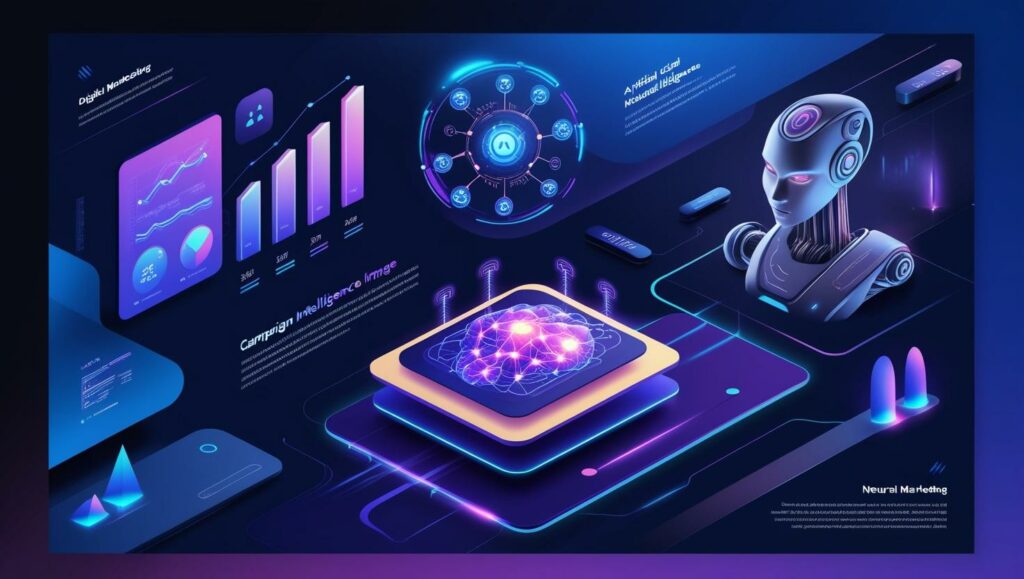Introduction
Artificial intelligence has come a long way in just a few short years. What was once the domain of research labs and science fiction is now helping marketers analyze billions of data points, personalize customer journeys, and even generate creative assets. These modern solutions—often dubbed “narrow AI”—excel at specific tasks, like writing ad copy or automating social media campaigns. Yet, as transformative as narrow AI has been, many experts foresee an even bigger leap on the horizon: Artificial General Intelligence (AGI).
AGI refers to a machine’s ability to learn and reason about virtually any domain, much like a human—only potentially faster and more accurately. Predictions about when AGI might emerge vary widely, from a mere decade away to half a century. Regardless of the exact timeline, conversations across LinkedIn, academic circles, and marketing conferences are converging on one key point: AGI in marketing and advertising could reshape the landscape forever, introducing new levels of speed, personalization, and creative potential.
In this blog, we’ll explore the concept of AGI, examine how it differs from today’s AI systems, and delve into practical steps you can take to prepare for a future where AI doesn’t just assist with marketing, but collaborates with and even guides it.
AGI vs. Narrow AI—What’s the Big Deal?
Understanding Today’s Narrow AI
Whether you’re using an automated ad-bidding platform or an AI that writes product descriptions, you’re already interacting with narrow AI. These systems:
- Perform specialized tasks, such as analyzing social sentiment or recommending items based on purchase history.
- Require human setup for each new domain or data set.
- Show remarkable skill in tasks they’re trained on, but can’t spontaneously tackle unrelated problems.
They’re powerful, but they’re still limited by their specialized design. That’s where AGI raises the bar: an intelligence that can generalize knowledge across domains, interpret large-scale objectives, and figure out the best path to achieve them—on its own.
2. The Big Leap to AGI
AGI is often described as “human-level” or even “superhuman-level” intelligence. In marketing terms, imagine an AI that:
- Develops an entire multi-channel campaign strategy from scratch—no explicit instructions needed.
- Monitors real-time performance, consumer sentiment, and competitor moves, adapting automatically.
- Generates, tests, and refines creative assets (videos, graphics, written copy) in line with brand guidelines.
It’s a scenario that flips the script: Humans might become high-level editors or brand stewards, while an AGI handles the relentless stream of data-crunching, optimization, and creative iteration.
“AGI isn’t just about intelligence in one area; it’s the capacity to self-direct, self-improve, and innovate in ways we typically associate with human creativity and strategic thinking.”
Signs of Progress Toward General Intelligence
1. Large Language Models (LLMs)
Systems like GPT-4 and beyond can already produce content, code, and reason to a surprising extent. While they lack “true understanding,” their performance across multiple tasks suggests a stepping stone toward more generalized intelligence.
2. Multi-Agent AI Ecosystems
Some marketing teams now employ multiple AI modules—one for ad creation, another for analytics, another for lead scoring—that communicate with each other. Although still “narrow,” these ecosystems hint at how a future AGI could coordinate all marketing functions seamlessly.
3. Reinforcement Learning in Marketing
Reinforcement learning (RL) has proven successful in complex environments (like game-playing or robotics). Translated to marketing, an RL approach might autonomously run thousands of campaign variants, “learning” optimal strategies for given audiences. Over time, as RL methods advance, we inch closer to machines that can adapt to any scenario, not just a single puzzle.
Google DeepMind’s co-founder Shane Legg predicted a high possibility of AGI in next 10 years. (Source: The Atlantic)
Impact on Marketing & Advertising
1. 24/7 Strategic Adaptation
With AGI at the helm, your marketing strategy wouldn’t just be a monthly or quarterly plan. It would be a living document, continuously updated in real time as the AI ingests performance data, consumer feedback, and external factors like global events or competitor launches.
Scenario: An AGI noticing a spike in negative sentiment about your brand might immediately revise messaging, launch targeted PR content, or even pivot an entire product strategy to address concerns—without waiting for human intervention.
2. Unprecedented Personalization
Hyper-personalization today typically means referencing someone’s first name or purchase history. AGI could seamlessly combine thousands of data points—shopping behavior, social media activity, cultural preferences—into content so custom-tailored it feels as if each user has a personal marketing assistant.
ROI: Personalized campaigns can already boost revenue up to 15%. In an AGI-driven future, that figure could shoot even higher, especially for industries like e-commerce, travel, and entertainment that thrive on personal relevance.
3. AGI as a Creative Partner
While there’s concern AI might replace human creatives, a more optimistic view sees a synergy. The machine proposes a vast range of creative possibilities—some off-the-wall, others data-informed—and humans pick, refine, or fuse them into a final concept. Over time, the AGI “learns” brand voice, comedic timing, or emotional resonance, possibly becoming an essential part of the brainstorming process.
Fun Thought: If you think writer’s block is tough, imagine asking your AGI to produce a hundred alternative lines, each tested for potential engagement metrics. The real challenge might be choosing which idea you like best!
4. Ethical & Governance Considerations
With great power (especially the power to shape public opinion on a massive scale) comes great responsibility. An advanced AI that can generate realistic fake videos, posts, or entire ad campaigns raises the stakes. Marketers will need robust ethical guidelines—defining what’s acceptable, ensuring transparency in AI-generated content, and respecting user privacy.
Pun intended: At least with an AGI, you can’t blame interns anymore for social media gaffes. The future scapegoat might be “the AI,” though brand reputations will still hinge on human oversight.
Real-World Mini Cases & Glimpses
- E-commerce Personalization at Scale
- Current Reality: A major online retailer uses advanced AI to recommend products, set dynamic pricing, and create targeted campaigns.
- AGI Potential: One day, a fully generalized system might coordinate every aspect of inventory management, supply chain optimization, and marketing collaterals, fine-tuned to real-time consumer demand worldwide.
- All-in-One AI Agency
- Current Reality: Some agencies already integrate copy generators, audience targeting tools, and analytics dashboards.
- AGI Potential: An all-in-one AI “super-agent” could run multi-brand campaigns, analyze cross-industry data sets, and propose new services based on emerging consumer patterns. Humans might just set brand ethics and do the final sign-off.
- AGI-Enhanced Crisis Management
- Current Reality: Social listening tools track mentions, sentiment, and trending topics, giving marketing teams a heads-up when trouble brews.
- AGI Potential: In a brand crisis—like a product recall or damaging rumor—AGI might simultaneously craft PR statements, liaise with legal teams, reconfigure ad spend, and even devise brand-rebuilding campaigns in minutes.
Preparing Today for Tomorrow’s AGI
1. Embrace Current AI Tools
Adopting narrow AI sets the stage for bigger leaps later. Familiarize your team with analytics platforms, generative copy tools, and automated bidding. This fosters a culture of AI acceptance and experimentation.
2. Nurture Hybrid Skill Sets
In a future shaped by AGI, marketers who bridge analytics, creative strategy, and ethical considerations will be in high demand. Encourage continuous learning—whether it’s data science basics or design principles.
Many top CMOs advocate for “AI fluency,” meaning your entire team understands AI’s core capabilities and limitations—even if they’re not data scientists.
3. Ethical Guidelines & Brand Voice Control
Develop a brand “code of conduct” for AI usage. If advanced AI can produce thousands of creative variations, you’ll need guardrails to prevent accidental off-brand or insensitive content.
Pun Intended: AI might inadvertently craft a pun that’s hilarious in one culture but offensive in another. A well-documented brand guideline can mitigate these cringe-worthy moments.
4. Monitor Emerging Tech & Collaborate
Stay informed on AI breakthroughs—subscribe to relevant newsletters, attend conferences, or partner with research institutions. Early adopters can often shape the direction of new marketing technologies, gaining a competitive edge.
Timeline & Future Outlook
1. Next 2–5 Years: Smarter Narrow AI & Proto-AGI
- Marketing platforms will grow increasingly integrated, featuring advanced predictive analytics and content generation.
- We might see early “proto-AGI” systems that can handle broader tasks but still require humans to set overarching goals.
2. 5–10 Years: Significant Strides Toward AGI
- Companies could experiment with partial automation of entire departments—ad creation, SEO, data analysis, and user experience design.
- Marketers become “conductors,” ensuring brand authenticity, ethics, and emotional intelligence remain front-and-center.
3. 10+ Years: Possible Emergence of True AGI
- If full AGI arrives, it could orchestrate global marketing campaigns, handle real-time consumer interactions across languages/cultures, and even propose new products or markets.
- In such a scenario, the lines between marketing, product development, and business strategy blur. AGI becomes an essential collaborator in every aspect of your business.
Conclusion: Charting a Course to the Future
The march toward AGI may be uncertain in timing, but it’s clear that AI capabilities in marketing are accelerating at a blistering pace. From automating campaign tasks to offering near-limitless creative variations, today’s narrow AI is a sneak preview of the transformative potential that general intelligence could one day unlock.
What does this mean for marketers and advertisers? It’s time to lean into AI—gain hands-on experience, build agile teams, and craft ethical guidelines that ensure a responsible rollout of emerging technologies. Human ingenuity, empathy, and cultural understanding will continue to anchor successful marketing. The difference is that soon, we’ll have an AI companion (or several) that can handle routine tasks, parse complex data sets, and even dream up new strategies, freeing us to focus on the bigger picture.
Call to Action: Ready to future-proof your marketing strategy? The Hype Trends is your partner in navigating the rapidly evolving AI landscape. Explore our “AI Futures Starter Kit” to learn how next-gen machine learning and intelligent systems can fit into your long-term marketing plan. Whether you’re AI-curious or already experimenting, we’re here to guide you toward an era where AGI isn’t just science fiction—it’s your brand’s secret weapon.
Sources & References
- Stanford’s AI Index – Annual, data-driven reports on global AI developments, including investment trends, technical breakthroughs, and policy discussions.
- OpenAI’s Research & Blog – Regular updates on cutting-edge AI research, tools like GPT-4, and broader discussions on AI ethics.
- DeepMind Publications – Groundbreaking work in reinforcement learning, deep learning, and other fields pushing the boundaries of AI.
- McKinsey: Artificial Intelligence Insights – Comprehensive studies on AI’s impact on various industries, including marketing and advertising ROI analyses.
- Harvard Business Review on AI – Thought leadership exploring the strategic, ethical, and organizational implications of AI in the business world.
- MIT Technology Review: AI Coverage – In-depth reporting on emerging AI tech, innovations, and global trends shaping the future of work and marketing.
- Deloitte: AI in the Enterprise – Data-driven insights and research on how enterprises are adopting and scaling AI solutions across different sectors.



